Review and photos by Bokisaurus
As far as uniqueness and spectacular ornamentation, Amargasaurus has held the distinction among sauropods as the one that stood out the most.But a recently discovered is about to challenge that title, and prove that there are many more bizarre dinosaurs out there just waiting to be discovered.
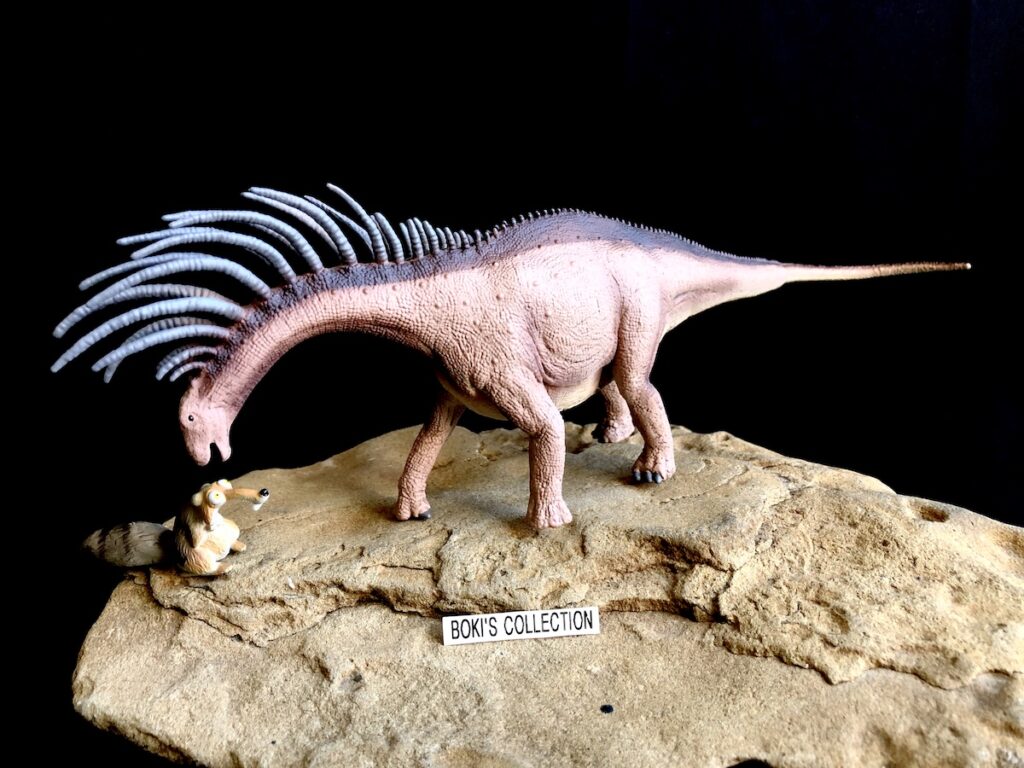
The badlands of Patagonia are today one of the world’s hot spot for new and unique dinosaur discoveries.In 2010 Argentine scientist discovered fossil remains of a medium size sauropod. Initially, only teeth were found by Argentinian palaeontologist Pablo Gallina. The fossil was found in the Bajada Colorada formation locality in Patagonia.Fossil bones found in this location are notoriously fragile so excavation was done in a single large block instead in lieu of typical bone-by- bone. The entire block containing the fossil would take years to prepare in the laboratory.
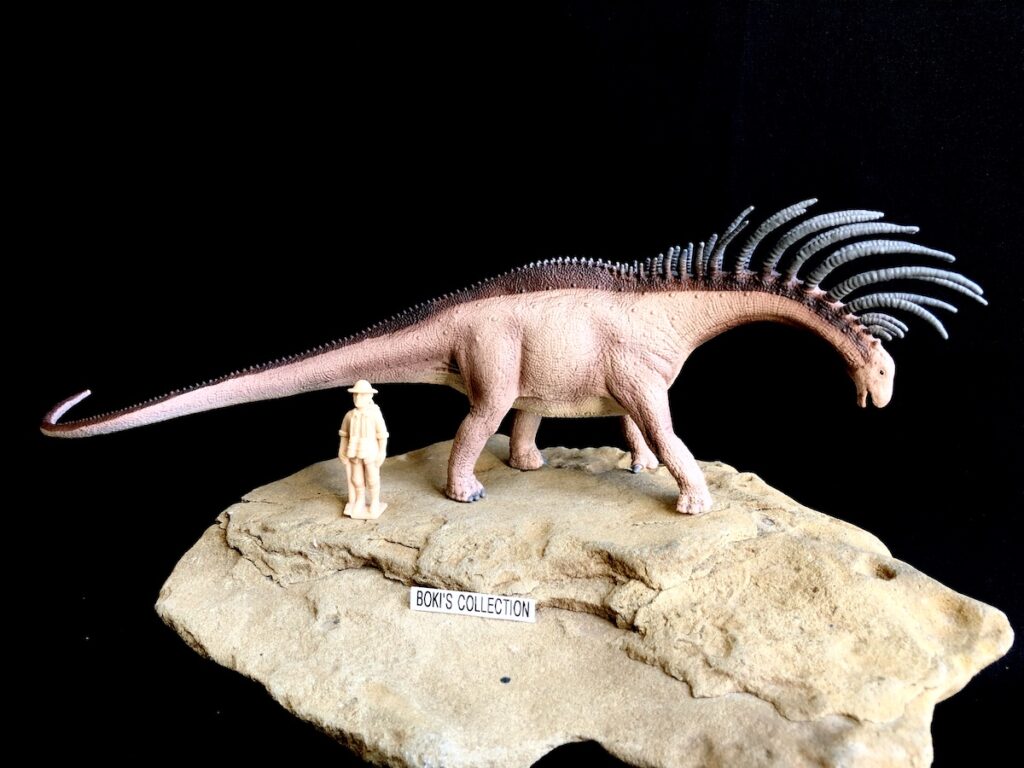
When preparation was completed, the beast that emerged proved to be one of the most unique and striking sauropods to be discovered yet.The formal announcement was first made by Gallina and colleagues in 2019, nine years after discovery. The new species was named Bajadasaurus pronuspinax, the species name means “lizard from Bajada with forward-bending spines” due to the unusual orientation of its neural spines.
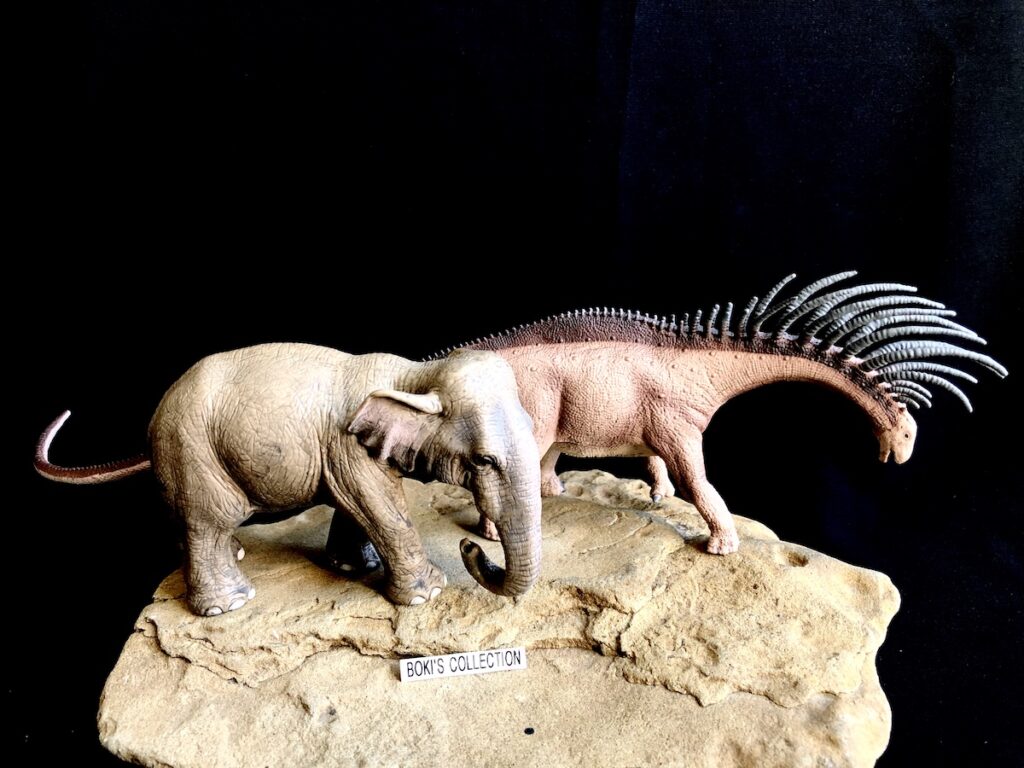
We all know that CollectA is a company that does not wait or shy away from producing figures of newly described or fragmentary species.From the formal announcement back in February of 2019, to the official CollectA reveal of the figure in late November, a span of nine months, that surely is a record for any company, even by Collecta’s own standard, the lightning speed in which they have produced a figure of this brand new species is amazing!
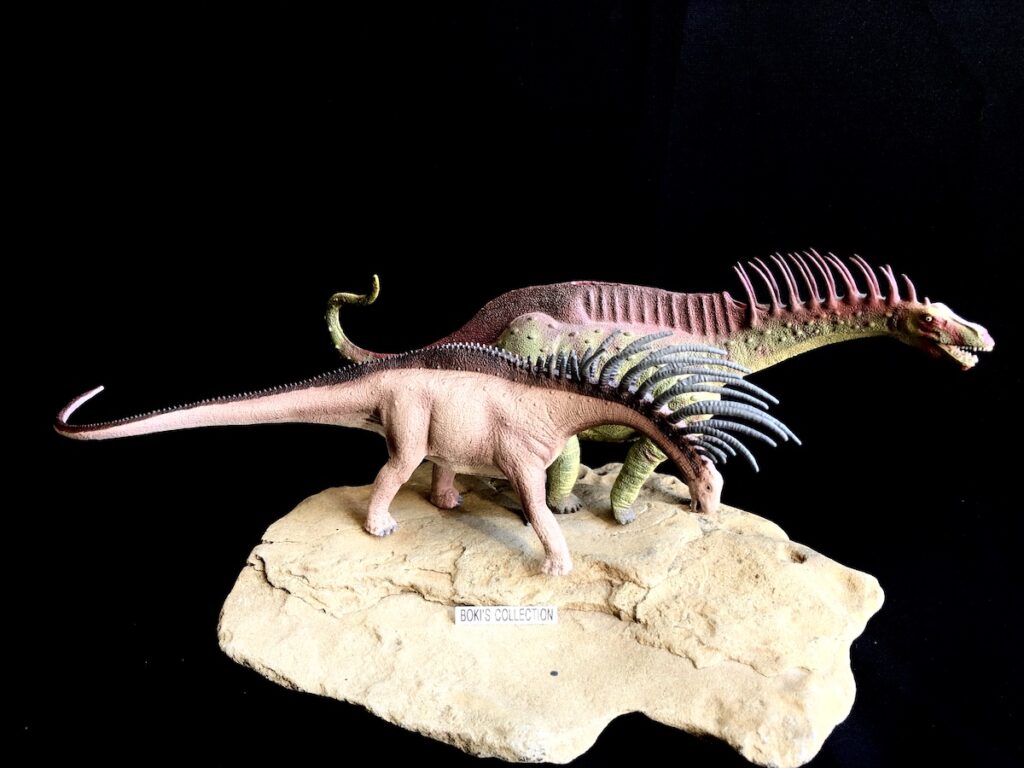
Bajadasaurus is classified as a member of the Dicraeosauridae, a group of mostly small to medium sized, short-necked sauropods from the middle Jurassic to the end of the Early Cretaceous. By sauropod standards, they are small, some comparable in body size to today’s elephants. The figure is officially part of the 1:40 scale, so the figure is not really that big, but bigger than what I expected measuring in at 3″inches tall and an impressive 15″ inches long stretched out from snout to tip of the tail!
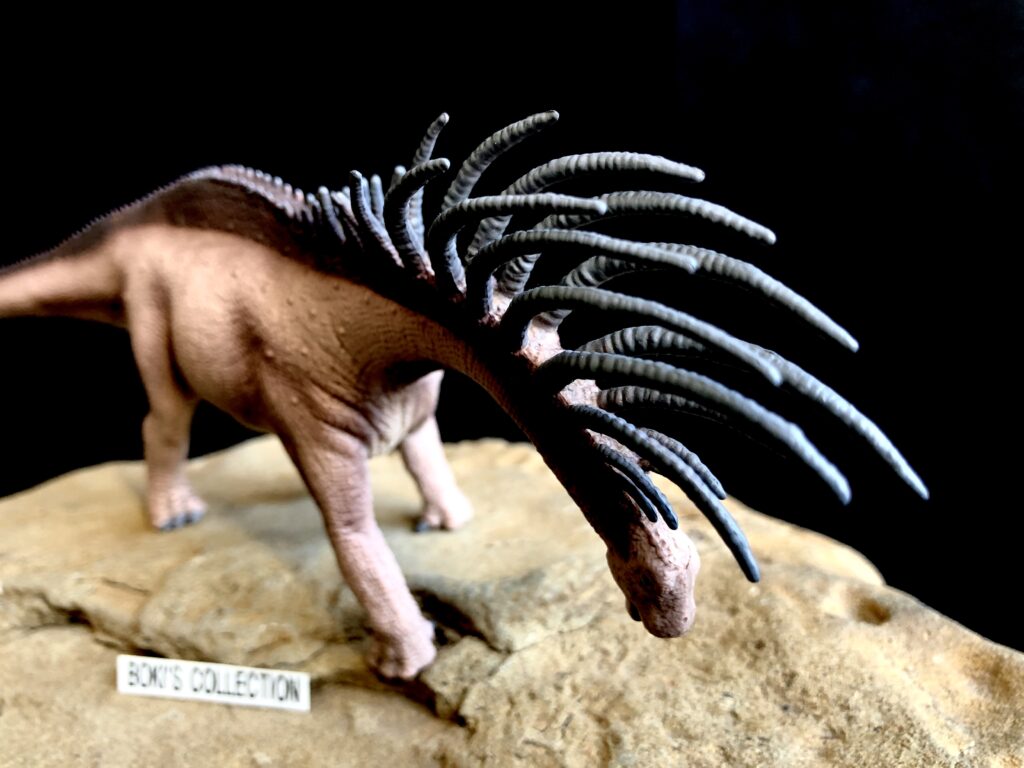
The fossil remains of Bajadasaurus are fragmentary, but what was found are important since it includes an almost complete skull, a rarity in sauropods, and a few neck vertebrae. Restoration is almost based on its close, more complete relative Amargasaurus, another South American sauropod . The skull is so important since it helped fill in the gap of what the head morphology of the group Dicraeosauridae looks like.
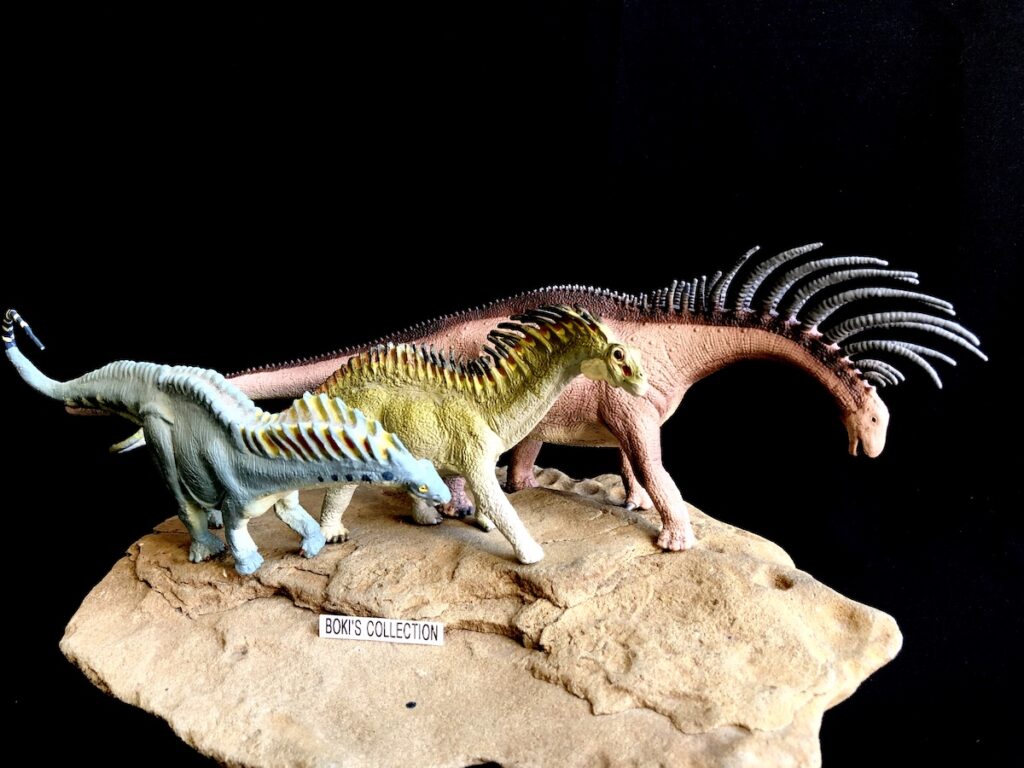
What is known is that the skull is slender and that the teeth are pencil-shaped and are restricted only to the front of the jaw. CollectA has done a good job on the head sculpt, in fact it is one of the best ones they have done, in addition they gave it lips, a rarity especially in sauropods.The mouth is open but with the lips you can’t really see the teeth but you can see very delicate details and even the tongue inside the mouth! There are also lots of small and delicate skin textures as well as scales. The eyes are painted black.
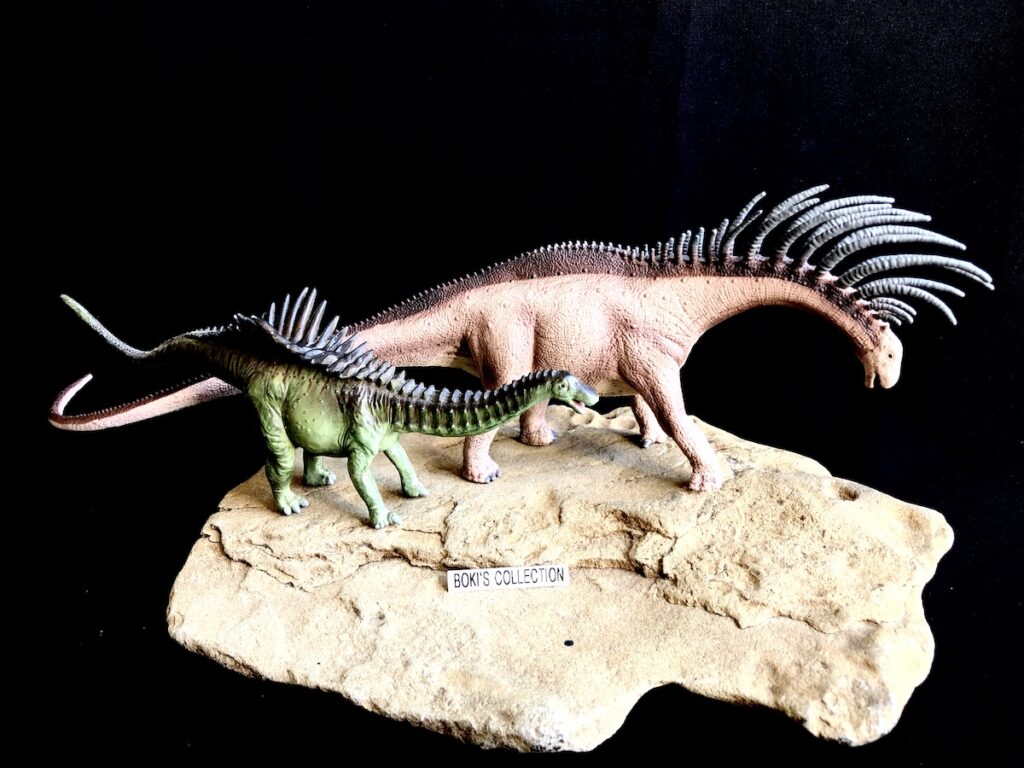
As for the rest of the body, unfortunately, not much was found. It is believed that since it is a close relative of Amarasaurus, that it probably is very similar in its body design as well as size, which is estimated to be around 10-13 meters based on available fossil material.
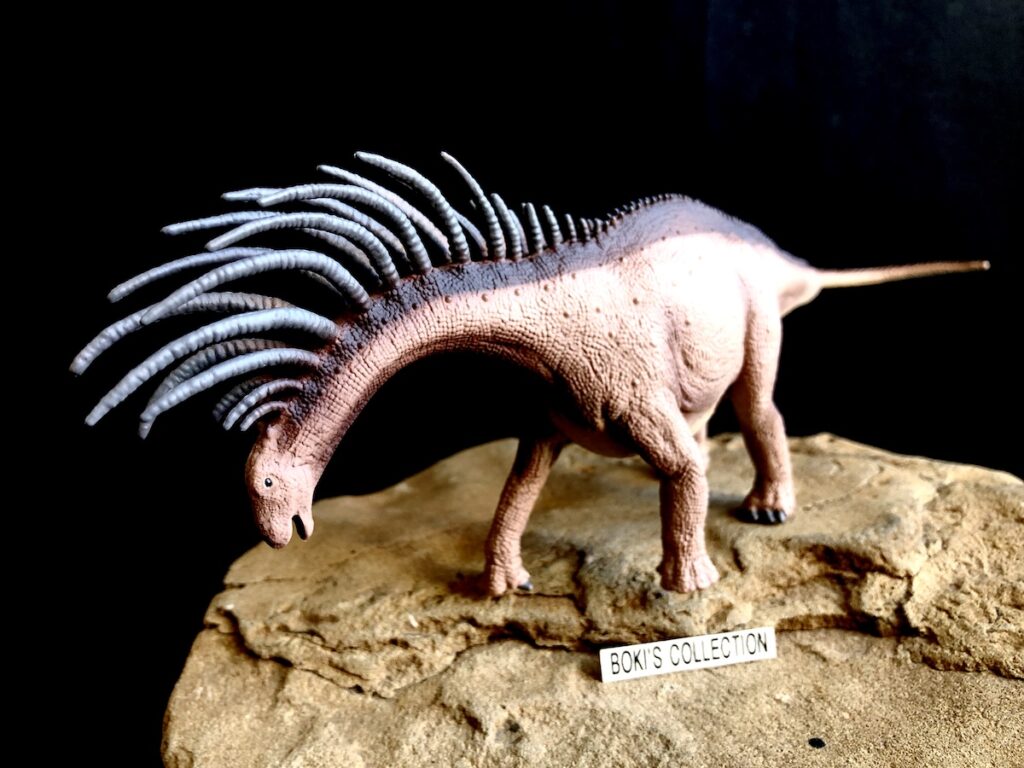
So, what makes Bajadasaurus such an unusual sauropod? One of the bones found was a single neck vertebra, while the exact location in the neck is not exactly known, some think that it could be either the sixth or seventh depending on which close relative it is compared with.What is amazing about this vertebra is that it sported an extremely long, elongated neural spine that were paired and stick out of the neck, very much like what we see in Amargasaurus.
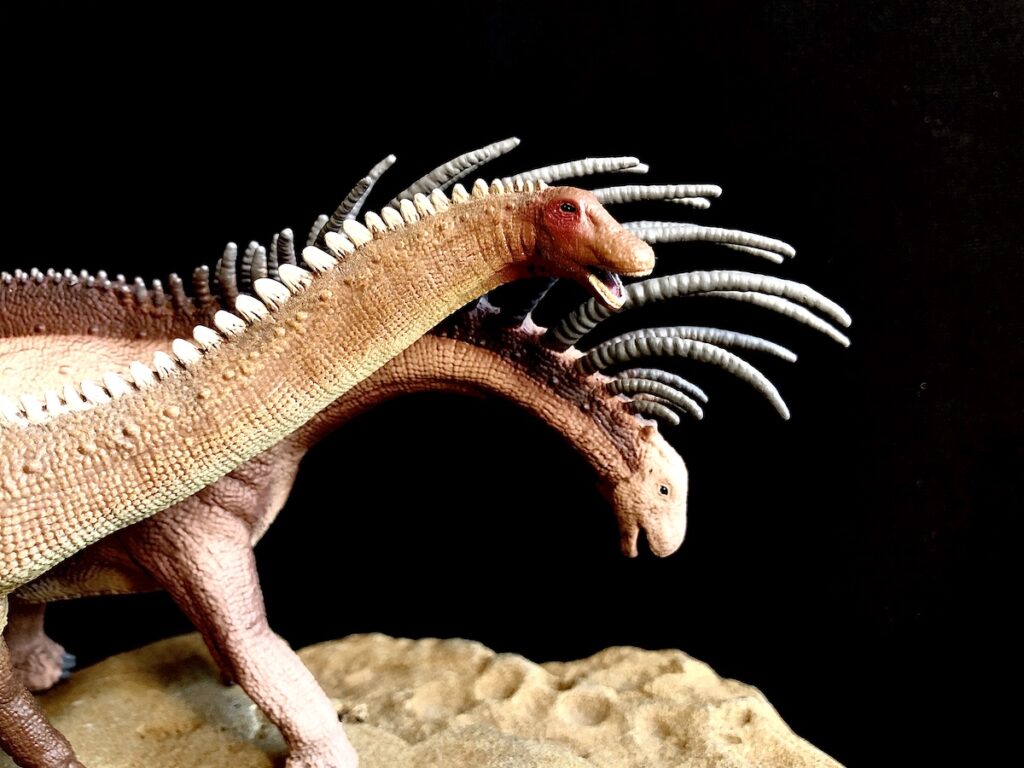
This pair of spines measures an impressive 23 inches in length, or almost 2 feet long! But what make the spines truly unique is its orientation. Instead of directed backward like what we see in Amargasaurus, these spines curved forward towards the front in a dramatic fashion! Now, due to the fragmentary nature of the fossil material, no one really knows what exactly and how many of these neck spines there are on the animal. It is clear that restoration of the animal is based on its close relative Amargasaurus, a species that came later. Its’ interesting that, if the neck spines indeed looks like that of Amargasaurs, how similar the two are, and how the orientation of these spine change direction in evolution seen in the much younger Amargasaurus. It is not believed that Bajadasaurus is an ancestor to the younger Amarga, any similarity could be just a product of convergent evolution.
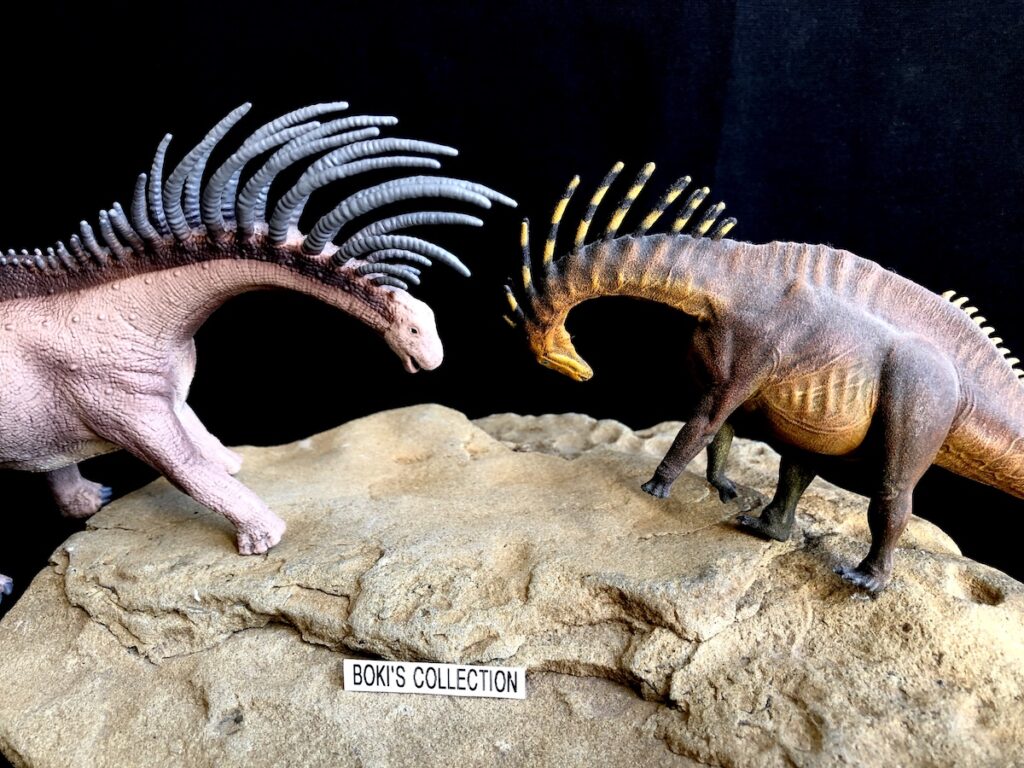
The paired neck spines on the figure are impressive: smaller one start off right after the head, and grow in length as it travels the neck. The longest of these spines are located in the middle, and from there the spines starts to shorten as it reaches the shoulder area.The result is that you have a truly impressive and unforgettable figure.
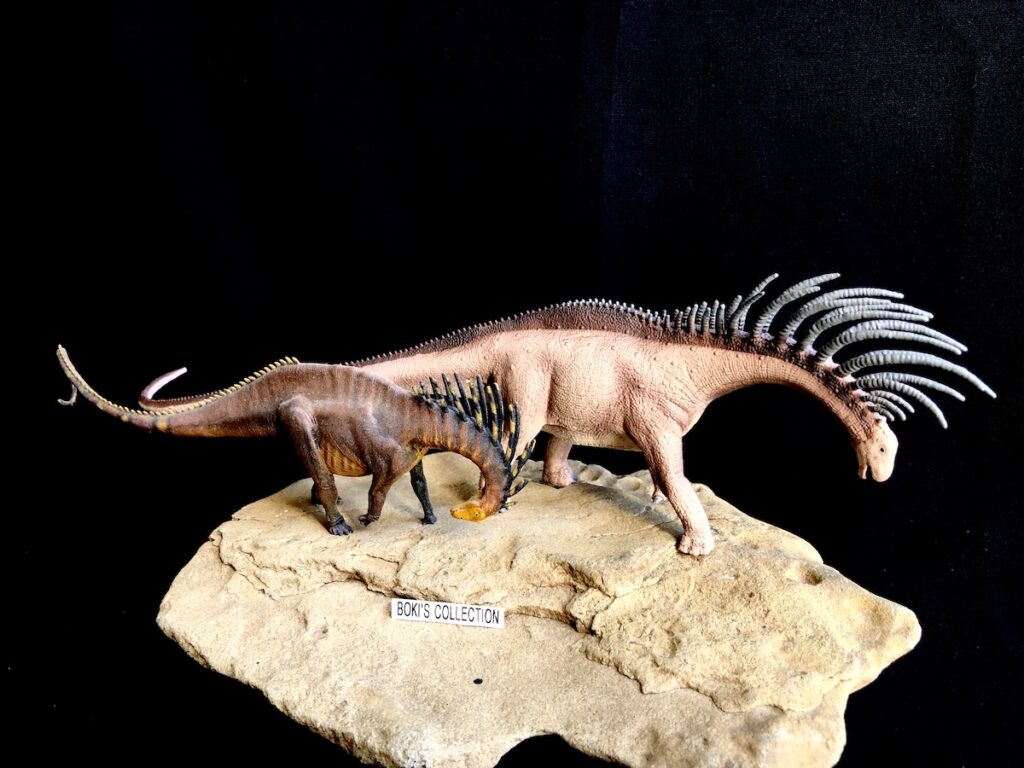
The material used for theses spike are softer, so they are prone to warping during transit if the plastic protection around it gets dislodge during transit.These spikes are given a light gray paint. The majority of Bajadasaurus restoration, from sculpture to 2D, show these neck spines as being covered in thick sheath of keratin and with visible striations that covers the bone, very much like that of the modern-day antelopes like the Oryx, and this figure from CollectA beautifully captured that in this figure.

The rest of the body is very well sculpted and show beautiful delicate details all over. There is skin fold in the parts where you would expect them to be. The scales on the body are appropriate for this size of a figure and is not distracting oversize. These scales are so small and delicate that it can be hard to see from a distance. You really have to see it in person to really appreciate these details as they are hard to capture in photos.
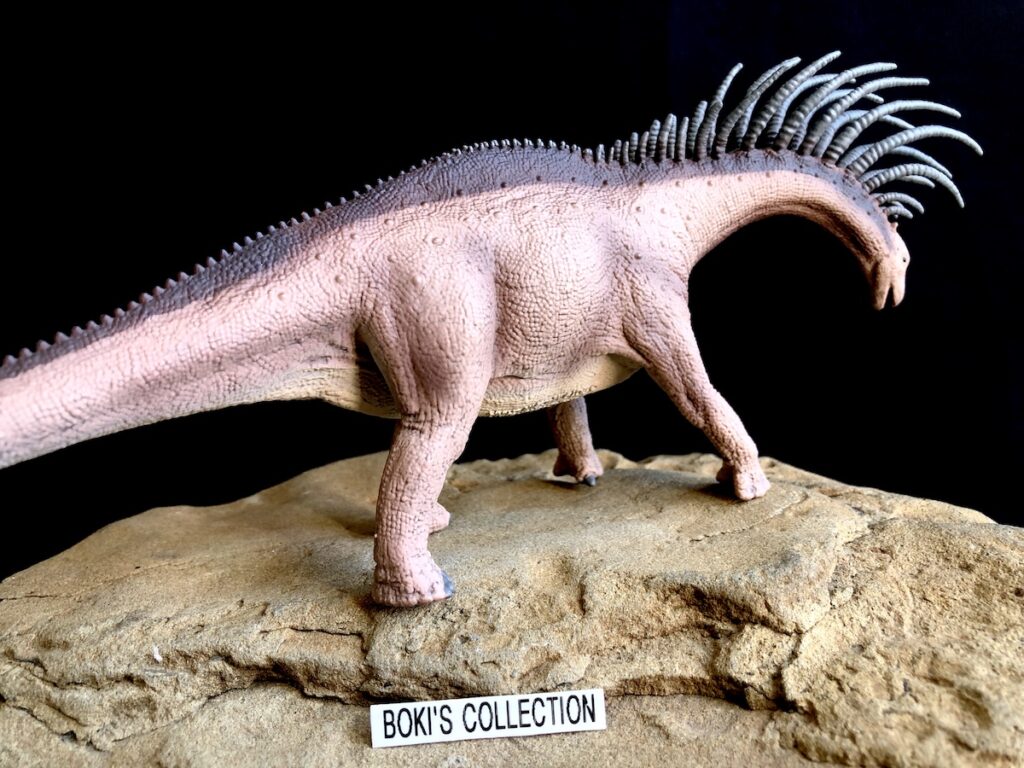
The tall paired neck spines form a double row of short spines as it reaches the base of the neck and continue halfway down the back before they converge and form a single row that runs all the way down the length of the tail. These spikes are much more in scale with the figure’s size and get smaller as it reaches the tail.
The pillar-like legs are nice and looks appropriately proportioned. The front feet accurately show the large nail as well as the crescent-shaped, and if you look closely, the foot pads even have delicate details on them.The middle back shows the typical small raised, hump-like shape seen on members of the family, but quickly slopes back as you travel towards the hips and tail.

The tail is very long on the figure, almost like something you would see on a diplodocus. The Base of it has the right thickness and you can see some nice muscle definitions. The tail is held high off the ground in a horizontal way for most of its length , only slowly curling sideways to the right as it reaches the last quarter.The material is, just like the spikes, made of softer material that could easily be warped during transit.

Now for the colors. The figure is given a simple color, mostly a light sandy brown on the majority of the lower half of the body. On the upper part, a darker brown band runs along the entire length of the figure, starting from the neck all the way down to the tail. The overall choice of subdued colors is appropriate for an animal of this size. That being said, the only real drawback is how straight this dark band looks like from a distance. This especially becomes distracting once it reaches where the stark contrast between the two brown hues creates an illusion of the body being much smaller that it is.
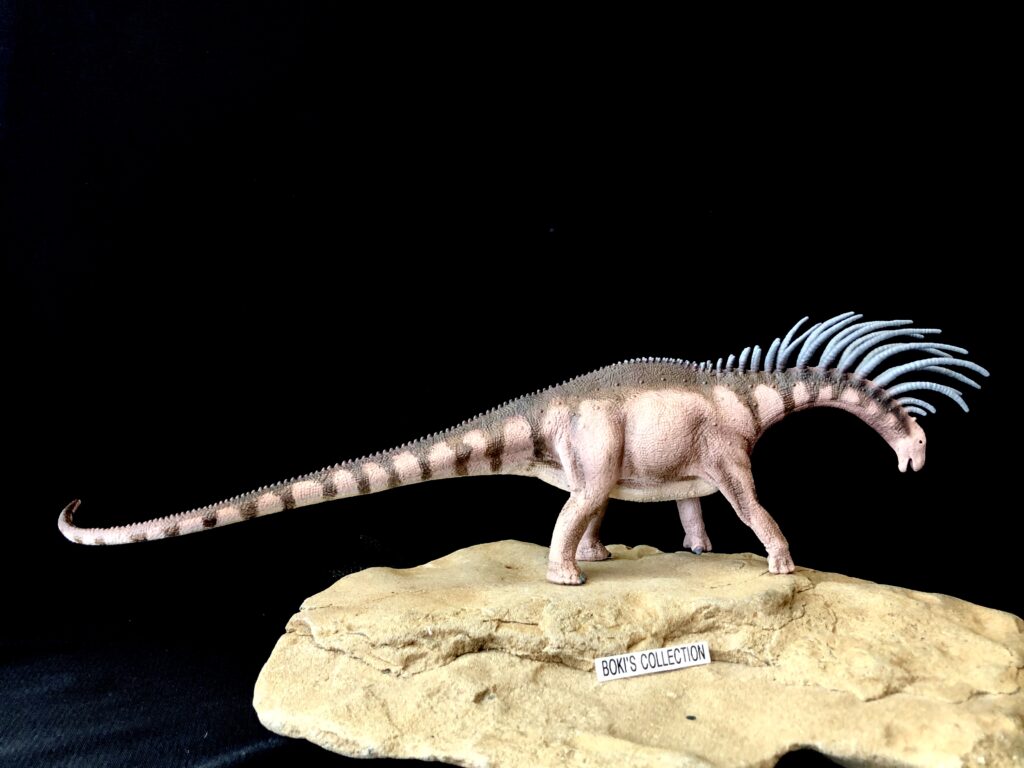
I’m actually surprised that CollectA’s design team did not break this waterline by pulling some of the darker color and creating stripes on the neck and bands on the tail. This would have made it more striking and more pleasing to the eyes.If you are adventurous or like repainting, this could be easy enough to do by carefully matching the colors and creating the desired effect. Despite this, I still like the color choices they gave the figure, simple yet believable for a large animal.
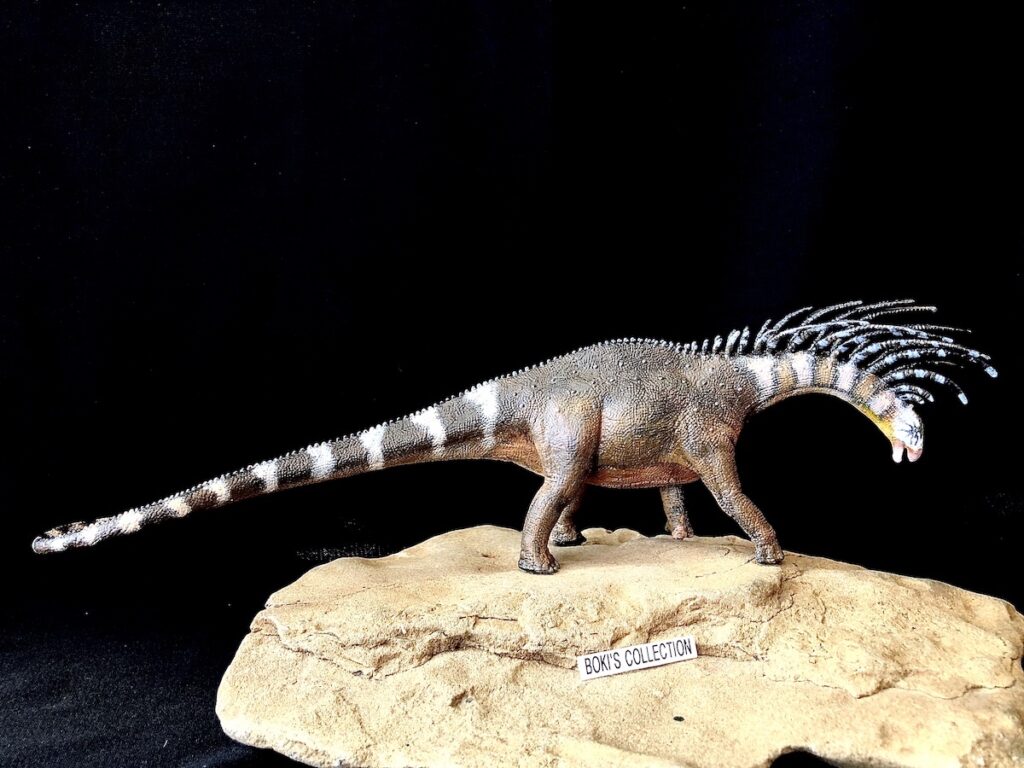
With a species whose fossil record is fragmentary, only time will tell if this truly unusual look will weather the test of time or would end up to be drastically different from what we currently know. A more complete fossil will help settle the debate.Until then, this sauropod surely belongs to the oddball hall of fame. This figure capture and will preserve what is currently known of this species if future find proves to be different from what we currently know.
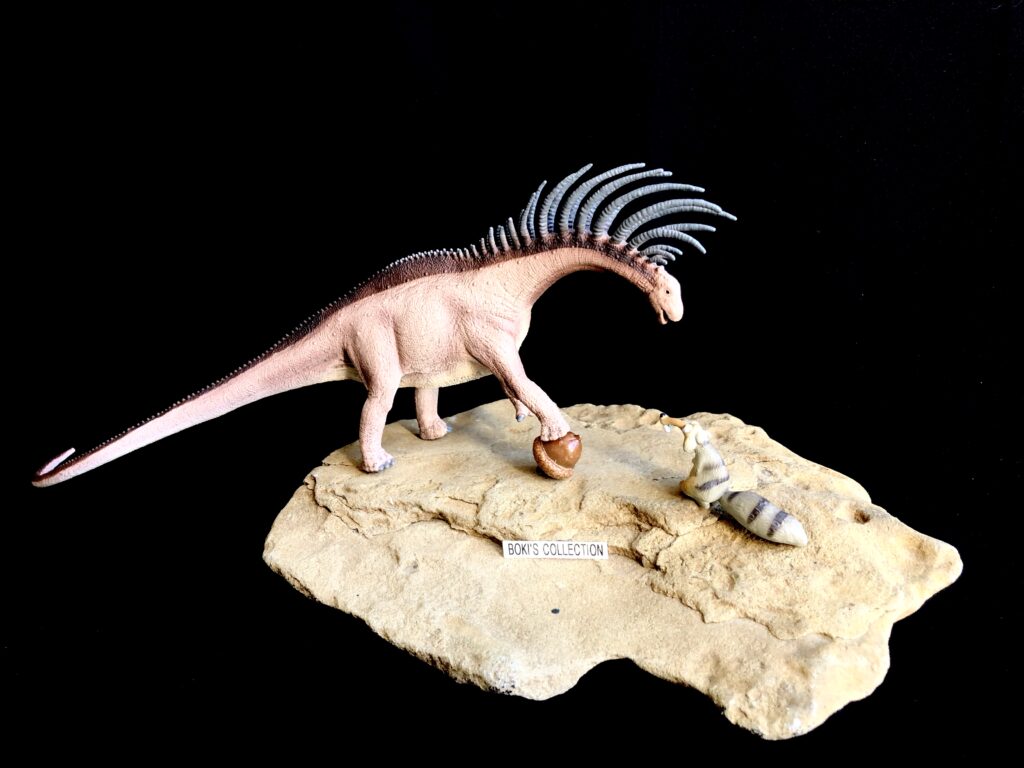
If unusual sauropod is your thing, then this new figure from CollectA definitely is a figure that you should absolutely get for your collection.It is very well sculpted and rich in details that surely will go down as one of Collecta’s best effort. The unique and striking appearance will surely garner attention in every collection especially when seen alongside more typical sauropods. What it lacks in size, it definitely makes up in its beauty.
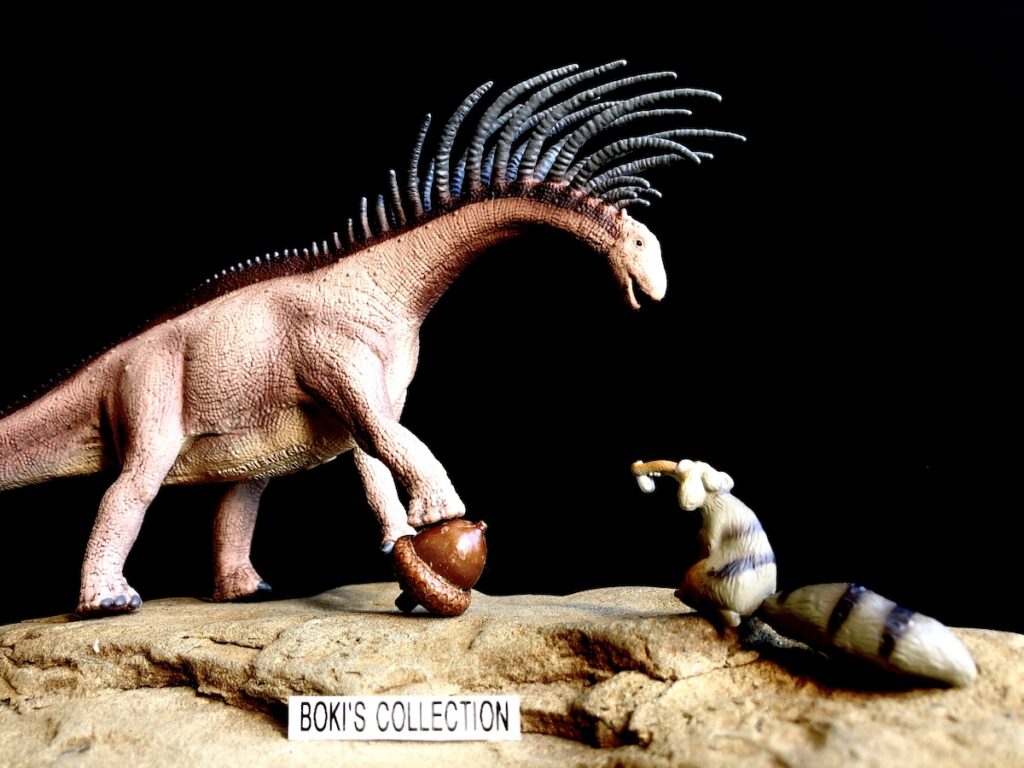
Well, I hope that you enjoyed the review, and thanks for reading! I hope you are all staying healthy and safe during this challenging times. Until the next review, Cheers!
Disclaimer: links to Ebay and Amazon on the DinoToyBlog are affiliate links, so we make a small commission if you use them. Thanks for supporting us!




Another strange and wonderful dinosaur. I always wondered if the orientation of the spines on Amargasaurus was correct, because pointing backwards, they would seem to hamper the animal when raising its neck, since they would foul on the back. And now we see that Baja, which came before Amarg had them swept forward, which to me is more practical, Makes me wonder even more if Amarg’s orientation is reconstructed correctly.
If this is considered to be convergent evolution in Baja and Amarg., then that would have to imply there was some practical, useful, important need for the spines. If purely ornamentation it is nearly impossible to imagine that two different animals would independently develop such similar display features, so close together in time. What possible useful purpose the neck spines could serve is beyond me. Hopefully some smart cookie will figure it out one day.
Great review.
Execelente reseña, lo encargué hace un tiempo y lo espero con ansias, colecciono figuras de 1:35 de preferencia y creo que para el tamaño de la figura representa a un animal dr unos 12 metros, lo que me parece muy bien, definitivamente tú esquema de color le luce excelente, el segundo me recuerda al busto en el museo. Muchas gracias saludos desde Chile
Very ressourcefull review of a nice figure…. what is that brown Amarga with the black/yellow spines?
Thanks! That figure is a Shapeway that Painted a few years back. It’s a great little figure.
Your repaint really brings out the underlying beauty of the model, once you take that harsh brown straight line out of the equation. An excellent review.
Thanks! Yeah, breaking up the waterline really helps. It really is surprising they didn’t do it.
Wonderful toy. I much prefer small sauropods to big ones. Really wish CollectA would do Dicraeosaurus and Brachtrachelopan.
Yes, I’m hoping as well that they would release either one or both!
Thanks for this very long article, the bajadasaurus is one of my favorite figures for the Collecta brand this year. It is a figure without a doubt detailed and worth having on the shelves.